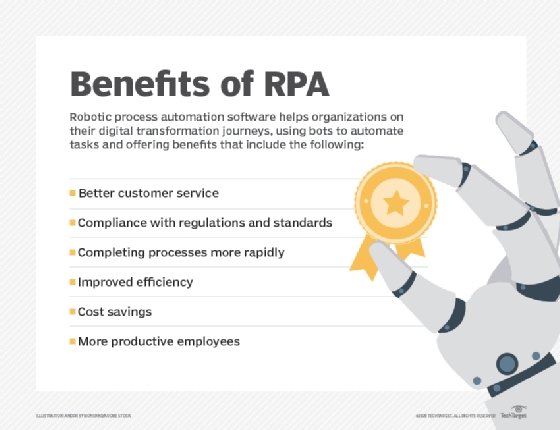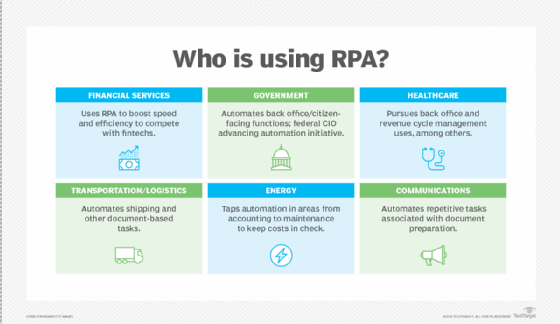
The 5 essential elements of an RPA strategy
RPA's benefits can be wiped out by an improper implementation. Give your business a sound RPA strategy and roadmap before you rush in.
Enterprises are turning to automation to increase operational efficiencies, lower costs and boost business responsiveness. This has fueled the market for low-code business process automation tools.
The robotic process automation (RPA) software market grew 60% from 2018 to 2019, making it the fastest-growing enterprise software segment, according to research firm Gartner. However, experts say too many organizations try to deploy RPA technology without proper preparation.
There are five fundamental things organizations need in place to have success with an RPA strategy. Here, we'll look at the details of these requirements.
1. Target processes for RPA strategically
Organizations need a clear strategic roadmap articulating the goals of their RPA efforts, said Kapil Kalokhe, senior director at Saggezza, a global management consulting and technology services firm. For example, is your priority to reduce costs, increase efficiencies, reduce risks or improve customer experience?
The most effective RPA strategies include guidance on how to identify, evaluate and prioritize the processes targeted for automation. Before automating, organizations should examine processes from end to end. Identify which processes are ready for automation now, and which need to be updated first. This exercise should also identify any tasks that are performed differently from worker to worker, and consequently need to be standardized before automation comes in.

"As much as we call this an automation tool, it's really about productivity and process improvement," said Mark Snyder, senior manager in West Monroe Partners' Operations Excellence practice.
2. Build a business and IT partnership
Business-side personnel need to be closely involved in identifying the business processes that will benefit from RPA. IT knows how to use RPA, but not where it's needed.
"The business leaders within their departments are closer [than IT] to the actual business challenges," Snyder said. "They're best positioned to identify what in their daily roles are logic-based decisions and manual repetitive tasks that are best for RPA."
RPA tools are often easy enough for non-technologists to use to build bots. That doesn't preclude IT from the RPA strategy. Many implementations need integration set up, or access to systems, that requires technical work from IT specialists.
The business-side needs a partnership with IT to build RPA bots that can scale. Technology teams should also provide training and support for business workers to use low-code RPA tools and deploy bots on their own as much as possible.
"I have yet to see citizen bot developers who can take out enough time from their regular schedules to figure out RPA tools on their own," Snyder said.

3. Institute an RPA champion and center of excellence
If RPA is a crucial tool for organizational success, the technology needs to be championed by a high-level manager or executive. This person will evangelize its benefits and build ongoing support for it throughout the enterprise.
"It's not enough to just automate a few processes," Kalokhe said. "You need a champion who can work across functions and drive through the cultural shift needed."
Experts suggest adopters task a team of workers with governing the organization's RPA best practices. This type of team -- often referred to as a center of excellence -- should pull from both business-side and IT workers. Ideally, it should include personnel from finance, compliance and human resource departments as well, to cover the economic, regulatory and human capital impact of RPA.
"For an organization to truly take advantage of the benefits of this technology, it has to be done at a program level with an RPA strategy behind it," said Tony Abel, RPA practice leader at consulting firm Protiviti.
4. Govern RPA
As RPA programs expand, workers will experience profound changes to their daily tasks. Organizations need to diligently communicate changes, help workers adjust and work with them to identify where automation does and doesn't pay off. An effective change management program should address how to adjust job requirements, upskill employees and support worker adoption of automation, Snyder said. Organizations should treat personnel issues such as training and knowledge development as part of its governance policy.
A smart RPA strategy should also definitively address development standards, security requirements, data privacy policies and access controls, Abel noted.
5. Invest in RPA monitoring tools
Teams need to monitor, manage and update RPA bots in operation. A good RPA strategy covers necessary monitoring and management, how it's implemented and tools that provide the capabilities to do so.
Consider tooling providers, such as Dynatrace or Kryon, that have the monitoring capabilities needed to map relationships between RPA components and continuously track bot performance.
Finally, create a plan to address and mitigate errors or problems that arise with the RPA implementation.








